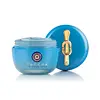What's inside
What's inside
 Key Ingredients
Key Ingredients

 Benefits
Benefits

 Concerns
Concerns

 Ingredients Side-by-side
Ingredients Side-by-side

Water
Skin ConditioningSqualane
EmollientDimethicone
EmollientPropanediol
SolventGlycerin
HumectantDiisostearyl Malate
EmollientOryza Sativa Bran Wax
Skin ConditioningBehenyl Alcohol
EmollientCamellia Sinensis Leaf
PerfumingIndigofera Tinctoria Leaf Extract
Skin ConditioningPolygonum Tinctorium Leaf/Stem Extract
Skin ConditioningAvena Sativa Kernel Extract
AbrasiveSophora Japonica Flower Extract
Skin ProtectingOryza Sativa Germ Oil
EmollientCocos Nucifera Oil
MaskingInositol
HumectantSericin
Skin ConditioningTetrasodium Tetracarboxymethyl Naringeninchalcone
Skin ConditioningAmorphophallus Konjac Root Powder
AbrasiveSodium Hyaluronate
HumectantSorbitan Tristearate
EmulsifyingTrihydroxystearin
Skin ConditioningDimethicone/Vinyl Dimethicone Crosspolymer
Skin ConditioningBeheneth-20
EmulsifyingBis-Diglyceryl Polyacyladipate-2
EmollientEthylhexylglycerin
Skin ConditioningButylene Glycol
HumectantSodium Dilauramidoglutamide Lysine
HumectantDisodium EDTA
Ethylhexyl Palmitate
EmollientSodium Acrylate/Acryloyldimethyltaurate/Dimethylacrylamide Crosspolymer
Emulsion StabilisingPhenoxyethanol
PreservativeCI 77891
Cosmetic ColorantMica
Cosmetic ColorantWater, Squalane, Dimethicone, Propanediol, Glycerin, Diisostearyl Malate, Oryza Sativa Bran Wax, Behenyl Alcohol, Camellia Sinensis Leaf, Indigofera Tinctoria Leaf Extract, Polygonum Tinctorium Leaf/Stem Extract, Avena Sativa Kernel Extract, Sophora Japonica Flower Extract, Oryza Sativa Germ Oil, Cocos Nucifera Oil, Inositol, Sericin, Tetrasodium Tetracarboxymethyl Naringeninchalcone, Amorphophallus Konjac Root Powder, Sodium Hyaluronate, Sorbitan Tristearate, Trihydroxystearin, Dimethicone/Vinyl Dimethicone Crosspolymer, Beheneth-20, Bis-Diglyceryl Polyacyladipate-2, Ethylhexylglycerin, Butylene Glycol, Sodium Dilauramidoglutamide Lysine, Disodium EDTA, Ethylhexyl Palmitate, Sodium Acrylate/Acryloyldimethyltaurate/Dimethylacrylamide Crosspolymer, Phenoxyethanol, CI 77891, Mica
Butyrospermum Parkii Butter
Skin ConditioningDimethicone
EmollientGarcinia Indica Seed Butter
Skin ConditioningMacadamia Integrifolia Seed Oil
Skin ConditioningGlycerin
HumectantGlyceryl Stearate
EmollientPEG-100 Stearate
Butylene Glycol
HumectantGossypium Herbaceum Seed Oil
Skin ConditioningSaccharide Isomerate
HumectantHoney
HumectantPanthenol
Skin ConditioningOphiopogon Japonicus Root Extract
Skin ConditioningCrocus Sativus Flower Extract
MaskingPadina Pavonica Thallus Extract
Skin ConditioningHydroxyethyl Acrylate/Sodium Acryloyldimethyl Taurate Copolymer
Emulsion StabilisingHydroxyethylcellulose
Emulsion StabilisingSimmondsia Chinensis Seed Oil
EmollientPropanediol
SolventSodium Polyacrylate
AbsorbentGlyceryl Caprylate
EmollientDisodium EDTA
Citric Acid
BufferingPolysorbate 60
EmulsifyingSorbitan Isostearate
EmulsifyingGlycine Soja Oil
EmollientEthylhexylglycerin
Skin ConditioningSodium Citrate
BufferingSodium Hydroxide
BufferingParfum
MaskingPhenoxyethanol
PreservativeSodium Benzoate
MaskingPotassium Sorbate
PreservativeTocopherol
AntioxidantGeraniol
PerfumingCitronellol
PerfumingButyrospermum Parkii Butter, Dimethicone, Garcinia Indica Seed Butter, Macadamia Integrifolia Seed Oil, Glycerin, Glyceryl Stearate, PEG-100 Stearate, Butylene Glycol, Gossypium Herbaceum Seed Oil, Saccharide Isomerate, Honey, Panthenol, Ophiopogon Japonicus Root Extract, Crocus Sativus Flower Extract, Padina Pavonica Thallus Extract, Hydroxyethyl Acrylate/Sodium Acryloyldimethyl Taurate Copolymer, Hydroxyethylcellulose, Simmondsia Chinensis Seed Oil, Propanediol, Sodium Polyacrylate, Glyceryl Caprylate, Disodium EDTA, Citric Acid, Polysorbate 60, Sorbitan Isostearate, Glycine Soja Oil, Ethylhexylglycerin, Sodium Citrate, Sodium Hydroxide, Parfum, Phenoxyethanol, Sodium Benzoate, Potassium Sorbate, Tocopherol, Geraniol, Citronellol
 Reviews
Reviews

Ingredients Explained
These ingredients are found in both products.
Ingredients higher up in an ingredient list are typically present in a larger amount.
Butylene Glycol (or BG) is used within cosmetic products for a few different reasons:
Overall, Butylene Glycol is a safe and well-rounded ingredient that works well with other ingredients.
Though this ingredient works well with most skin types, some people with sensitive skin may experience a reaction such as allergic rashes, closed comedones, or itchiness.
Learn more about Butylene GlycolDimethicone is a type of synthetic silicone created from natural materials such as quartz.
What it does:
Dimethicone comes in different viscosities:
Depending on the viscosity, dimethicone has different properties.
Ingredients lists don't always show which type is used, so we recommend reaching out to the brand if you have questions about the viscosity.
This ingredient is unlikely to cause irritation because it does not get absorbed into skin. However, people with silicone allergies should be careful about using this ingredient.
Note: Dimethicone may contribute to pilling. This is because it is not oil or water soluble, so pilling may occur when layered with products. When mixed with heavy oils in a formula, the outcome is also quite greasy.
Learn more about DimethiconeDisodium EDTA plays a role in making products more stable by aiding other preservatives.
It is a chelating agent, meaning it neutralizes metal ions that may be found in a product.
Disodium EDTA is a salt of edetic acid and is found to be safe in cosmetic ingredients.
Learn more about Disodium EDTAEthylhexylglycerin (we can't pronounce this either) is commonly used as a preservative and skin softener. It is derived from glyceryl.
You might see Ethylhexylglycerin often paired with other preservatives such as phenoxyethanol. Ethylhexylglycerin has been found to increase the effectiveness of these other preservatives.
Glycerin is already naturally found in your skin. It helps moisturize and protect your skin.
A study from 2016 found glycerin to be more effective as a humectant than AHAs and hyaluronic acid.
As a humectant, it helps the skin stay hydrated by pulling moisture to your skin. The low molecular weight of glycerin allows it to pull moisture into the deeper layers of your skin.
Hydrated skin improves your skin barrier; Your skin barrier helps protect against irritants and bacteria.
Glycerin has also been found to have antimicrobial and antiviral properties. Due to these properties, glycerin is often used in wound and burn treatments.
In cosmetics, glycerin is usually derived from plants such as soybean or palm. However, it can also be sourced from animals, such as tallow or animal fat.
This ingredient is organic, colorless, odorless, and non-toxic.
Glycerin is the name for this ingredient in American English. British English uses Glycerol/Glycerine.
Learn more about GlycerinPhenoxyethanol is a preservative that has germicide, antimicrobial, and aromatic properties. Studies show that phenoxyethanol can prevent microbial growth. By itself, it has a scent that is similar to that of a rose.
It's often used in formulations along with Caprylyl Glycol to preserve the shelf life of products.
Propanediol is an all-star ingredient. It softens, hydrates, and smooths the skin.
It’s often used to:
Propanediol is not likely to cause sensitivity and considered safe to use. It is derived from corn or petroleum with a clear color and no scent.
Learn more about Propanediol